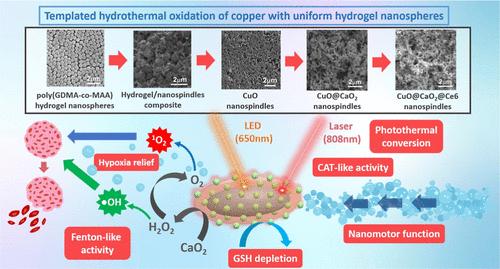Copper(II) Oxide Spindle-like Nanomotors Decorated with Calcium Peroxide Nanoshell as a New Nanozyme with Photothermal and Chemodynamic Functions Providing ROS Self-Amplification, Glutathione Depletion, and Cu(I)/Cu(II) Recycling
IF 8.3
2区 材料科学
Q1 MATERIALS SCIENCE, MULTIDISCIPLINARY
引用次数: 0
Abstract
Uniform, mesoporous copper(II) oxide nanospindles (CuO NSs) were synthesized via a method based on templated hydrothermal oxidation of copper in the presence of monodisperse poly(glycerol dimethacrylate-co-methacrylic acid) nanoparticles (poly(GDMA-co-MAA) NPs). Subsequent decoration of CuO NSs with a CaO2 nanoshell (CuO@CaO2 NSs) yielded a nanozyme capable of Cu(I)/Cu(II) redox cycling. Activation of the Cu(I)/Cu(II) cycle by exogenously generated H2O2 from the CaO2 nanoshell significantly enhanced glutathione (GSH) depletion. CuO@CaO2 NSs exhibited a 2-fold higher GSH depletion rate compared to pristine CuO NSs. The generation of oxygen due to the catalase (CAT)-like decomposition of H2O2 by CuO@CaO2 NSs resulted in a self-propelled diffusion behavior, characteristic of a H2O2 fueled nanomotor. These nanostructures exhibited both peroxidase (POD)-like and CAT-like activities and were capable of self-production of H2O2 in aqueous media via a chemical reaction between the CaO2 nanoshell and water. Usage of the self-supplied H2O2 by the POD-like activity of CuO@CaO2 NSs amplified the generation of toxic hydroxyl (•OH) radicals, enhancing the chemodynamic effect within the tumor microenvironment (TME). The CAT-like activity provided a source of self-supplied O2 via decomposition of H2O2 to alleviate hypoxic conditions in the TME. Under near-infrared laser irradiation, CuO@CaO2 NSs exhibited photothermal conversion properties, with a temperature elevation of 25 °C. The combined GSH depletion and H2O2 generation led to a more effective production of •OH radicals in the cell culture medium. The chemodynamic function was further enhanced by an elevated temperature. To assess the therapeutic potential, CuO@CaO2 NSs loaded with the photosensitizer, chlorine e6 (Ce6), were evaluated against T98G glioblastoma cells. The synergistic combination of photodynamic, photohermal, and chemodynamic modalities using CuO@CaO2@Ce6 NSs resulted in cell death higher than 90% under in vitro conditions.

氧化钙纳米壳修饰的具有光热和化学动力学功能的新型纳米酶氧化铜(II)纺轴状纳米马达,提供ROS自扩增、谷胱甘肽耗竭和Cu(I)/Cu(II)循环
在单分散聚甘油二甲基丙烯酸-共甲基丙烯酸纳米粒子(聚(GDMA-co-MAA) NPs)的存在下,采用模板水热氧化铜的方法合成了均匀介孔氧化铜纳米锭子(CuO NSs)。随后用CaO2纳米壳(CuO@CaO2 NSs)修饰CuO NSs,得到了一种能够进行Cu(I)/Cu(II)氧化还原循环的纳米酶。CaO2纳米壳外源产生的H2O2激活Cu(I)/Cu(II)循环,显著增强谷胱甘肽(GSH)耗竭。CuO@CaO2 NSs的GSH耗竭率是原始CuO NSs的2倍。CuO@CaO2 NSs通过过氧化氢酶(CAT)样分解H2O2产生氧气,导致自推进扩散行为,这是H2O2燃料纳米发动机的特征。这些纳米结构具有过氧化物酶(POD)样和cat样活性,并且能够通过CaO2纳米壳与水之间的化学反应在水介质中自我产生H2O2。CuO@CaO2 NSs的pod样活性利用自身提供的H2O2,增加了有毒羟基(•OH)自由基的产生,增强了肿瘤微环境(TME)内的化学动力学效应。cat样活性通过H2O2的分解提供了自供O2的来源,以缓解TME中的缺氧状况。在近红外激光照射下,CuO@CaO2 NSs表现出光热转换特性,温度升高25℃。GSH的消耗和H2O2的生成共同导致细胞培养基中更有效地产生•OH自由基。升高的温度进一步增强了化学动力学功能。为了评估治疗潜力,CuO@CaO2 NSs负载光敏剂氯e6 (Ce6),对T98G胶质母细胞瘤细胞进行了评估。在体外条件下,使用CuO@CaO2@Ce6 NSs的光动力、光热和化学动力学模式的协同组合导致细胞死亡率高于90%。
本文章由计算机程序翻译,如有差异,请以英文原文为准。
求助全文
约1分钟内获得全文
求助全文
来源期刊

ACS Applied Materials & Interfaces
工程技术-材料科学:综合
CiteScore
16.00
自引率
6.30%
发文量
4978
审稿时长
1.8 months
期刊介绍:
ACS Applied Materials & Interfaces is a leading interdisciplinary journal that brings together chemists, engineers, physicists, and biologists to explore the development and utilization of newly-discovered materials and interfacial processes for specific applications. Our journal has experienced remarkable growth since its establishment in 2009, both in terms of the number of articles published and the impact of the research showcased. We are proud to foster a truly global community, with the majority of published articles originating from outside the United States, reflecting the rapid growth of applied research worldwide.
 求助内容:
求助内容: 应助结果提醒方式:
应助结果提醒方式:


